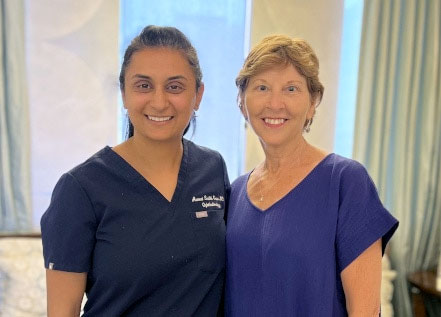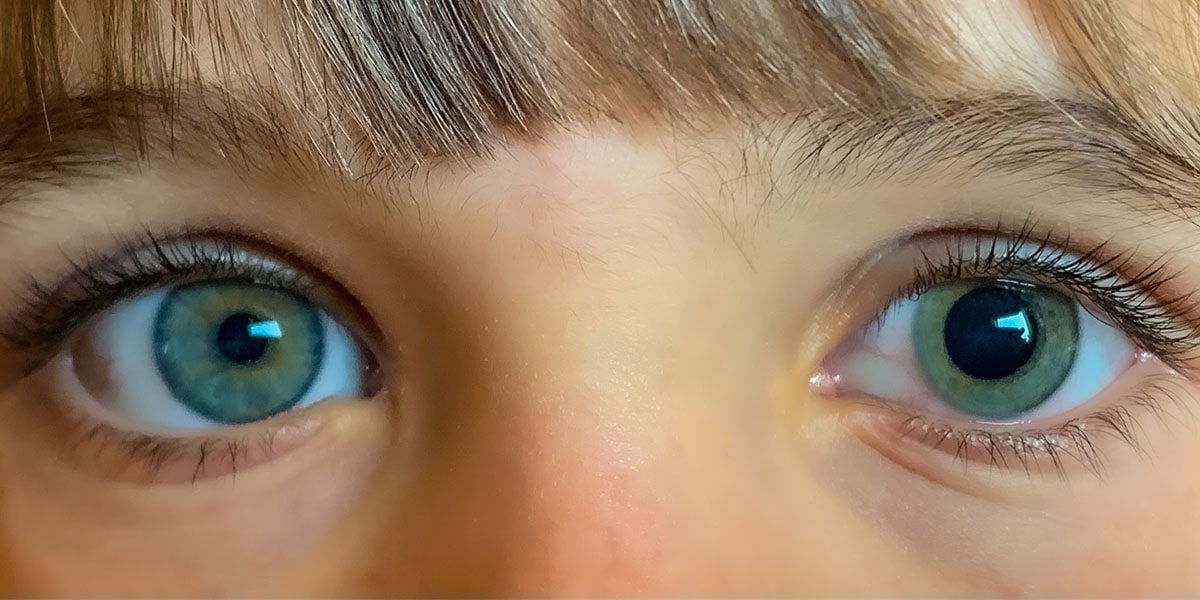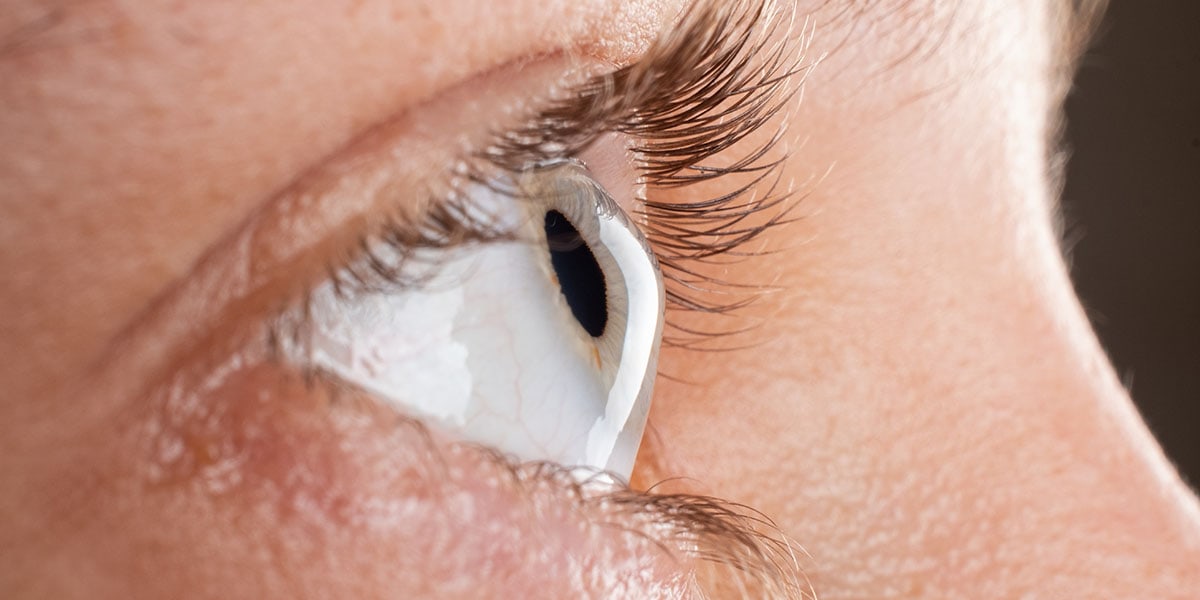- Home
- Patient Stories from Assil Gaur Eye Institute
- Light Adjustable Lens Gives Ellen Visual Clarity
Light Adjustable Lens Gives Ellen Visual Clarity

Like most people in the United States, Ellen Leggett spent the first two years of the pandemic sequestered in her home. Far away from her office and classroom at USC and away from the closed Los Angeles County courtrooms, where she worked as a jury consultant.
During this time, Ellen, 70, began to suspect that she needed a new prescription for her glasses and made a mental note to make an appointment with her optometrist. “I didn’t notice changes, but I would have when the world opened back up again,” she says, remembering her time alone.
Post-pandemic, Ellen began feeling unsure of her night driving skills and had difficulty seeing her students sitting in the back of her lecture hall. Ellen is now a retired psychologist and former director of the master’s program at USC.
- "Take Me Out to the Ballgame" as Steve Can Now See Thanks to the Odyssey Lens!
- EagleVision® LASIK Gives Optometrist Crystal-Clear Active Life
- After Waiting 50 Years, Larry Gets Perfect Vision
- Ally Sheds Her Glasses After State-of-the-Art Odyssey Lens Replacement
- Light Adjustable Lens Gives Ellen Visual Clarity
- Light-Adjustable Lens Heals Jacqueline’s Cloudy Sight
- Actress Tiffany Smith Says Goodbye to Nearsightedness with LASIK
- Aram, a Civil Engineer is Back on Track with New Odyssey Cataract IOL Lens
- Cutting-edge Odyssey IOL lens lets Greta, a busy optometrist, toss her glasses aside
- EagleVision® LASIK Prepares Snowboarder for Olympics
- Eye Freckle Removal Surgery Worth a Cross-Continent Trip
- Sylvia says ‘lazy eye and cloudy vision be gone’ with Odyssey IOL replacement!
- Emily’s Urgent Retina Care Saves Her Eyesight
- Aaron travels from China for the ‘Magic of EagleVision' LASIK
- Nancy is glowing about her new PanOptix® IOL
- Perri, 39-year-old Cataract Patient, Finds Clear Vision 500 Miles from Home
- Dr. Richardson says AGEI stands at the top of eye surgery specialists
- Super lawyer Marc Katz enjoys life without glasses after enVista lens exchange
- Dan loves being glasses-free after Refractive Lens Exchange
- Merry Resolves Severe Ocular Complications with Perfect Monofocal IOL
- Steven Can Finally See His Own Reflection After RLE
- Janet, a Texas Teacher, Travels to Beverly Hills for Eye Freckle Removal
- It’s A Wonderful Life for Mike with 20/20 Vision and New Odyssey IOLs
- Kevin Says Eye Freckle Removal Surgery Was Well Worth the Wait
- Stacy Finds Second Eye Surgery’s the Charm thanks to AGEI
- Lucy’s Trip from Australia to Beverly Hills for Conjunctival Nevi Removal: A Worthwhile Journey
- With Her Cataracts Gone, Young Sara Sees like a Hawk!
- Adrenaline Junkie Finally Rides Safely Thanks to Odyssey IOL
- Julie After Her EagleVision LASIK Procedure
A cataract diagnosis
A visit to her optometrist confirmed that her eyes needed help, but not the kind of first aid a new glasses prescription could provide. It turns out that she had developed a cataract in each eye. “I was surprised it was cataracts,” she remembers. “Though things started seeming fuzzier.”
Her eye doctor strongly recommended the Assil Guar Eye Institute of Los Angeles (AGEI). Ellen quickly made an appointment with Dr. Avneet K. Sodhi Gaur, who ran a series of tests to confirm the right approach to Ellen’s vision problems and recommended the adjustable light lens. To say that Ellen was impressed with Dr. Gaur would be an understatement. “She was a real pro. An amazing doctor, extremely skilled, a compassionate clinician, and a warm person.”
While there are several options for adjustable lenses, Dr. Gaur chose RxSightTM adjustable light lenses for Ellen’s procedure.
The adjustable light surgery experience
The surgery was scheduled as a two-hour outpatient procedure at the AGEI surgery center. Once Ellen was administered a gentle sedative, Dr. Gaur inserted anesthetic eye drops and made a 2 mm wide incision through the cornea at the border of the iris and the white of the eye using a precise LensAR Femtosecond Laser.
Dr. Gaur inserted a tiny probe through the incision and broke down the cataract using gentle ultrasound energy (phacoemulsification). Once the cataract was in small pieces, the doctor gently swept them up like a vacuum. The posterior lens capsule was left intact to serve as a pocket to hold the new artificial lens.
Once the hazy natural lens was removed, the doctor used the ORA System™ to gain precise measurements. ORA is a cutting-edge technology that takes an intra-operative picture of the eye after the new IOL has been inserted to verify that the nearsightedness, farsightedness, or astigmatism has been corrected.
The new lens was then inserted into the eye through a pen-like instrument. Once the lens is released into the eye, it unfurls into a round disc and is tucked into the proper place within the lens capsule.
No stitches were required.
Fine-tuning the sight
Ellen was given two pairs of protective glasses — one with clear lenses, one with brown lenses — to keep out ultraviolet rays. She wore them every minute unless bathing or sleeping. During the recovery process, she also had eye drops that needed to be applied daily to assist in healing.
The doctor provided Ellen with several visual options to find the best prescription lens for her. After narrowing it down and finding the one that provided the most precise vision, she began her light treatments.
The doctor used a Light Delivery Device (LDD) to adjust the lens to fit her prescription. The LDD delivers UV light to a photosensitive material that helps modify the shape of the lens.
The LDD is placed on the anesthetized eye, one eye at a time, while the other eye is covered with a patch to avoid the light scattering into it. The treatments can last anywhere from a few seconds to about two minutes.
Ellen underwent two 90-second light treatments. Between the treatments, she continued to wear her protective glasses.
The RxSightLight Adjustable Lens is made of unique photosensitive silicone material that undergoes subtle changes in lens power and shape when exposed to carefully dosed ultraviolet light. This technology lets the doctor adjust your lens power and curvature better to address refractive errors.
The result?
During the next two months, Ellen was impressed by Dr. Gaur’s bedside manner. “She was always available to answer questions, checked in with text, and even met after hours to check my eyes,” says Ellen. “This is a good example of how a doctor should behave with patients.”
Just after Labor Day, Ellen celebrated having 20/20 vision. “I haven’t seen this well since college,” she says. “The only glasses I have are sunglasses. Plus, I realized my care at the practice had been with amazing female doctors.”
Why trust your eyesight to Assil Gaur Eye Institute?
Under Dr. Assil’s leadership, the Assil Gaur Eye Institute has assembled a team of top ophthalmology specialists from around the country who continue AGEI’s tradition of offering patients the highest quality of specialist eye care in the United States. In keeping with the founding principles of AGEI, our doctors have managed to keep their clinics comfortable and familiar, much like how family-run medical practices used to be.
Today, the Assil Gaur Eye Institute is nationally recognized for its compassionate patient-centric care, its commitment to pioneering advances in ophthalmology, and its dedication to supporting the health and well-being of its patients and community.
Please call (866) 945-2745 or make an appointment online.
We are conveniently located for patients throughout Southern California and the Los Angeles area at locations in or near Beverly Hills, Santa Monica, West Los Angeles, West Hollywood, Culver City, Hollywood, Venice, Marina del Rey, Malibu, Manhattan Beach, and Downtown Los Angeles.














